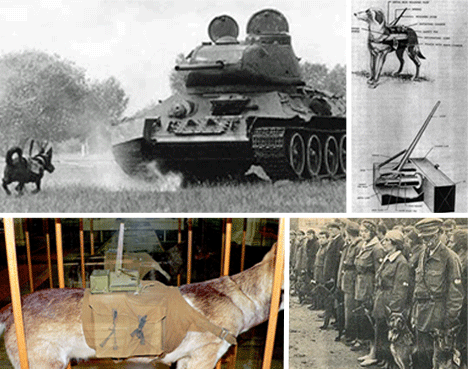- Joined
- Aug 18, 2010
- Messages
- 1,314
- Likes
- 149
In war, innovation can mean the difference between a glorious victory and a world shattering defeat. When research and development departments have the funding of a desperate nation behind them, and are faced with a long and brutal campaign, the ideas that are spawned can turn the tide of battle. It's inevitable that some of the wilder ideas would later seem ridiculous. Here are 10 of the most extreme, and odd, military weapons created in the 20th century:

The brutality of war can be reflected by the means with which it's fought. Anti tank dogs were a soviet creation, and said to have taken down over 300 German tanks during World War II. Dogs were taught to find food under tanks, and then starved before a battle. They would have bombs strapped to their backs, with levers that would trigger as soon as it hit the underside of a tank. When the lever snapped back, the dogs would explode, destroying the tank. The Germans eventually fought this tactic with flamethrowers, and a couple cases of dogs running amok away from battlefields was enough to cut back the program.

Corkscrew tanks didn't run on the typical caterpillar type treads, instead propelled by giant corkscrews. Just like an electric screwdriver pulls into a piece of wood, so these treads would cruise along the ground, regardless of terrain. Their travel was a bit erratic, and the tanks had to be too lightweight to be useful in combat.


When it comes to urban fighting, every corner can hide a group of enemy soldiers. Even the slightest advantage can win battles, so various weapons were designed to allow soldiers to see around corners, and fire around them behind the protection of a concrete wall.

War Dogs - Tank Busters
The brutality of war can be reflected by the means with which it's fought. Anti tank dogs were a soviet creation, and said to have taken down over 300 German tanks during World War II. Dogs were taught to find food under tanks, and then starved before a battle. They would have bombs strapped to their backs, with levers that would trigger as soon as it hit the underside of a tank. When the lever snapped back, the dogs would explode, destroying the tank. The Germans eventually fought this tactic with flamethrowers, and a couple cases of dogs running amok away from battlefields was enough to cut back the program.

CorkScrew Tanks
Corkscrew tanks didn't run on the typical caterpillar type treads, instead propelled by giant corkscrews. Just like an electric screwdriver pulls into a piece of wood, so these treads would cruise along the ground, regardless of terrain. Their travel was a bit erratic, and the tanks had to be too lightweight to be useful in combat.

Corner Kicking Guns

When it comes to urban fighting, every corner can hide a group of enemy soldiers. Even the slightest advantage can win battles, so various weapons were designed to allow soldiers to see around corners, and fire around them behind the protection of a concrete wall.
































